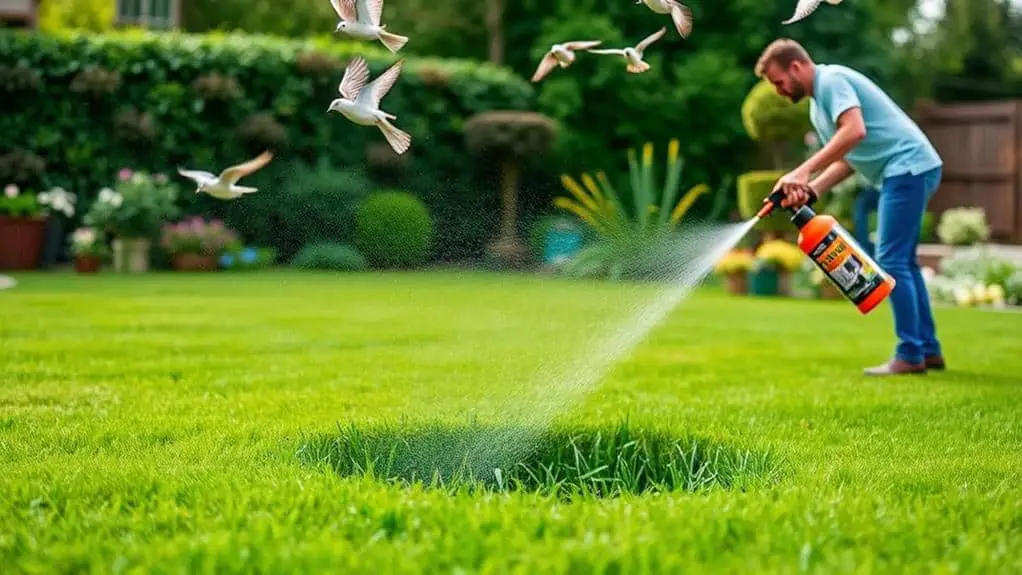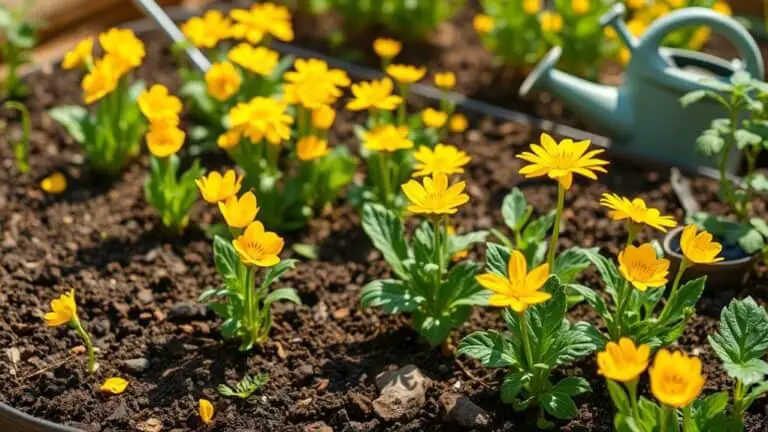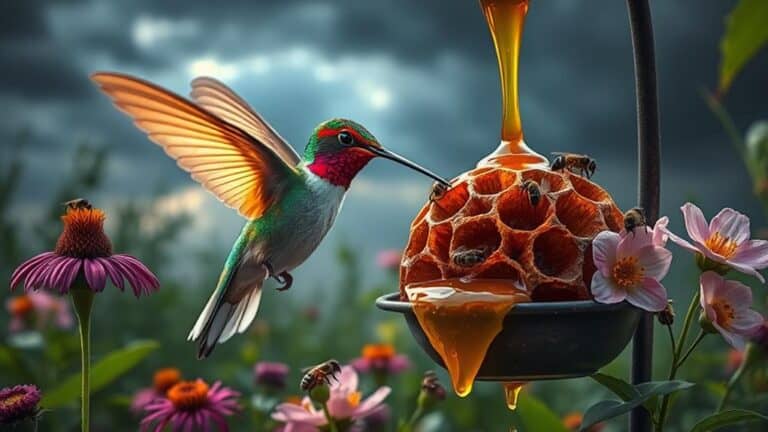How To Keep Birds From Eating Grass Seed
When you're seeding your lawn, birds can quickly become a major nuisance, snatching up seeds before they have a chance to germinate. To effectively protect your investment, you'll need a strategy that combines various deterrents and barriers. Have you considered using bird netting or reflective objects? These methods can greatly reduce seed loss, but they're just the beginning. By employing a mix of techniques, you can create a more bird-proof environment. Curious about the best ways to implement these tactics and guarantee your grass grows uninterrupted? Let's explore some practical solutions.
Common Bird Types

When it comes to protecting your freshly sown grass seed, knowing the common bird types that target these seeds is essential. Sparrows, finches, pigeons, blackbirds, and meadowlarks are the usual culprits.
These birds love the nutrient-rich grass seeds and can quickly deplete your hard work. Sparrows and finches are small and often forage in open areas. Pigeons, especially in urban settings, are notorious for scavenging and causing significant seed loss.
Blackbirds flock together, making them capable of rapid seed consumption. To prevent birds from eating your seeds, it's vital to understand their feeding habits and peak activity times.
Lay Out Bird Netting
Understanding the common bird types that target your grass seeds is the first step in protecting your lawn.
One highly effective method for keeping birds away is to lay out bird netting over the seeded area. This creates a physical barrier that stops birds from accessing the grass seed, while still letting sunlight and water through.
Make sure the netting is flat against the ground to prevent ruffling, which could allow birds to sneak underneath. Anchor the edges properly to avoid any gaps.
Regularly check the netting for wear or damage and make adjustments as needed. This humane approach not only protects your seeds but also keeps birds as part of your ecosystem.
Place Physical Deterrents

To effectively keep birds from eating your grass seed, placing physical deterrents in your garden can be a game-changer. Hang shiny objects like aluminum plates or mylar bands around the seeding area; their reflective movements scare birds. Use decoys, such as fake owls, to deter smaller birds. Scarecrows and reflective objects should be moved regularly to prevent birds from getting used to them. Bird netting or mesh, laid flat on the ground, stops birds from reaching the seeds while allowing sunlight and moisture through. Visual deterrents like garden stakes with streamers create movement and noise, making the area less inviting for birds.
| Physical Deterrent | Purpose |
|---|---|
| Shiny Objects | Reflective movements scare birds |
| Decoys | Fake predators deter smaller birds |
| Scarecrows | Move regularly to maintain effectiveness |
| Bird Netting | Creates a barrier while allowing light and moisture |
Using these methods will help protect your grass seed from hungry birds.
Use Straw or Mulch
Covering your newly sown grass seed with a thin layer of certified weed-free straw or mulch can be highly effective in keeping birds at bay.
This straw mulch helps obscure the seeds, reducing their visibility and access for birds. It also retains moisture and regulates soil temperature, promoting seed germination.
Use about 100 kg of straw or mulch for a 100 m² lawn to guarantee proper coverage. Regularly check the mulch layer to keep it intact, as a disturbed layer won't effectively protect the seeds.
While straw mulch is cost-effective, remember to remove it once the seeds germinate. This guarantees the young grass gets the light it needs to grow strong and healthy.
Install Sound Machines

After laying down straw or mulch to protect your grass seed, you might consider adding sound machines to your arsenal.
These devices emit loud noises or recordings of predatory bird calls, effectively scaring away small birds. Options range from cannon-like sounds to natural predator calls, providing diverse auditory deterrents.
Place sound machines in areas where bird activity is high, especially during morning and evening peak feeding times. For a quieter option, windchimes can also startle birds without being too disruptive.
Remember, regular maintenance and repositioning of these devices are essential. Birds may get used to static sounds, so keep changing their locations to guarantee continued effectiveness.
Your grass seed will thank you!
Hang Bird Feeders
Hanging bird feeders at the edges of your growing areas can effectively provide birds with an alternative food source, reducing their interest in freshly sown grass seeds.
Position the feeders away from the planted areas to divert birds' attention and keep birds away from the grass seed. Using a variety of seeds, like sunflower or millet, will attract birds to the feeders instead.
Regularly refill the bird feeders to guarantee a consistent food supply, encouraging birds to visit the feeders rather than your lawn.
Make sure the feeders are at a height and in a location that's easy for birds to reach but far enough from the grass seed to prevent access.
This simple step can really help protect your lawn.
Apply Bird Repellent

Often, applying a non-toxic bird repellent spray can effectively make grass seeds unappetizing to birds, markedly reducing seed loss during germination. You can find these sprays at garden centers, and they're safe for your plants.
To keep birds away, reapply the repellent every two weeks. Strong scents like peppermint oil can also deter birds naturally. These repellents are budget-friendly, costing as low as $12.50 per acre.
For the best results, combine bird repellents with other deterrent methods, such as using physical barriers or reflective materials. This combination will enhance the survival rates of your grass seed.
Cover Seeds With Soil
Covering grass seeds with a thin layer of soil is a simple yet effective way to protect them from birds. When you cover seeds with soil, you're creating a barrier that reduces visibility and access, keeping birds from feasting on them. Aim for a depth of about 1/4 to 1/2 inch, allowing light and soil moisture to reach the seeds for ideal germination.
| Action | Benefit |
|---|---|
| Cover seeds with soil | Protects seeds from birds |
| Water immediately | Settles soil, secures seeds |
| Monitor regularly | Adjusts protection if needed |
Applying 100 kg of cover material per 100 m² guarantees an effective way to protect your lawn. Don't forget to water the soil right after sowing, which helps further secure the seeds.
Use Reflective Objects

When trying to protect your newly sown grass seed, using reflective objects can be a highly effective strategy.
Hanging old CDs or strips of aluminum foil around your lawn will create movement and light reflections that scare birds away. For a 70-square-meter lawn, set up three strings of foil spaced 1-2 meters apart to keep birds away.
The shiny surfaces of these reflective objects mimic predators, so birds are less likely to approach. Regularly moving the objects keeps them effective, as static deterrents might lose their threat over time.
This method is cost-effective and reusable, making it a great choice to protect your grass seed during future sowing seasons.
Give it a try and watch your grass thrive!
Employ Visual Scare Tactics
To keep birds from eating your grass seed, try using visual scare tactics.
Hang reflective objects like old CDs or aluminum foil to scare them off with movement and light.
You can also set up fake owls or hawks and move them around regularly to keep birds wary.
Reflective Materials Placement
Birds can be a real nuisance when it comes to protecting your newly sown grass seed, but utilizing reflective materials is an effective visual scare tactic to keep them at bay.
Hanging items like CDs or foil strips at 1-2 meter intervals across your lawn creates movement that mimics predators. This can effectively scare birds away from your grass seed.
For a 70 m² lawn, use at least three strings of reflective materials for good coverage.
- Hang reflective materials like CDs or foil strips.
- Place them 1-2 meters apart.
- Use at least three strings for a 70 m² lawn.
- Move them regularly to maintain effectiveness.
These shiny deterrents confuse birds, making them a cost-effective and reusable solution.
Predator Decoy Setup
Strategically placing predator decoys in your lawn can greatly reduce the chances of birds eating your grass seed.
Positioning fake owls or other predator decoys around your yard acts as a strong visual deterrent, scaring away smaller birds like sparrows and finches.
Make sure to set the decoys at different heights and spots to mimic real predator behavior. This boosts their effectiveness.
Don't forget to move them every few days, so they stay threatening.
Combine these decoys with other scare tactics, such as reflective materials, to increase the visual impact.
Always choose decoys that look like local predators.
Movable Scare Devices
One effective method to keep birds from eating your grass seed is by using movable scare devices.
These devices create the illusion of human presence or predators, which can help safeguard your seeds. Here are some ideas you can try:
- Scarecrows: Made from sticks and old clothing, these can be moved around to stay effective.
- Reflective materials: Hang aluminum foil strips or old CDs to create light reflections that scare birds.
- Fake owls: Place decoys of owls or other birds of prey around your lawn to simulate natural threats.
- Moving flags or streamers: Combine these with reflective objects for enhanced deterrence.
Remember to regularly change the location of these devices, so birds don't get used to them.
Frequently Asked Questions
What Stops Birds From Eating Grass Seed?
You can stop birds from eating grass seed by using bird deterrent methods like effective scare tactics with reflective items, natural repellents, or garden netting solutions. These strategies keep birds away and protect your seeds.
How Do I Protect My Grass Seed?
You can protect your grass seed by using seed covering methods, bird deterrent devices, and effective lawn maintenance tips. Employ seed germination techniques like covering seeds with compost, using netting, and installing reflective or auditory deterrents.
How to Keep Birds and Rabbits From Eating Grass Seed?
To keep birds and rabbits from eating grass seed, use bird deterrent methods like garden netting solutions and reflective items. Implement rabbit repellent techniques such as mulch or straw covers. Natural predators like decoys also deter them.
How Do You Protect Seeds From Birds?
You can protect seeds from birds by using bird deterrent methods like garden netting and seed covers. Natural repellents and reflective items also help. Monitor bird activity and adjust seeding times for better results.
Conclusion
You've got this! By following these steps, you're well on your way to protecting your grass seed from hungry birds. Use netting, straw, and soil to cover seeds. Add some shiny objects or visual scare tactics to keep birds at bay. Don't forget sound machines and bird feeders to divert their attention. With a bit of effort and creativity, you'll soon see your grass growing strong and healthy. Happy gardening, and good luck!






